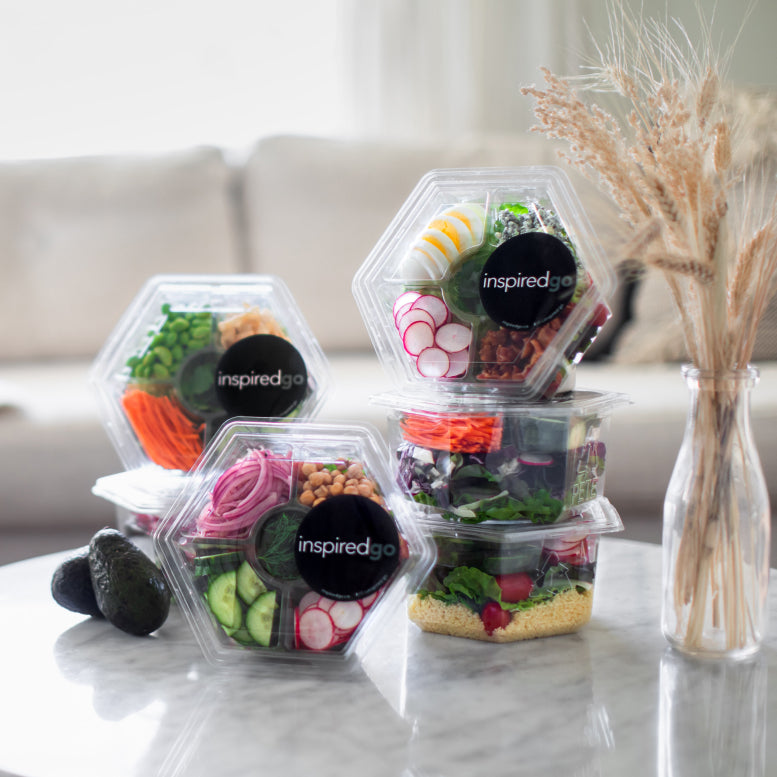How Many Calories In A Salad?
Table of Contents
1. Exploring Caloric Content in Inspired Go's Salads
2. Is a Cobb Salad Healthy?
3. Is Caesar Salad Healthy for You?
4. How Many Calories Are in a Taco Salad?
1. Exploring Caloric Content in Inspired Go's Salads
When investigating the caloric content of salads, it's essential to note that the number can considerably vary based on the ingredients used. At Inspired Go, we craft salads with a diverse range of nutrient-rich ingredients, providing a balanced mix of flavors without compromising health benefits. Each salad's caloric content is meticulously calculated and clearly provided, allowing for informed dietary choices. Our salads, such as the Everything Bagel Salad or the Classic Fattoush Salad, are engineered for health-conscious individuals, ensuring that they have a delicious, satisfying meal that aligns with their nutritional goals. With our transparent approach to nutrition information, customers can easily keep track of their daily caloric intake and maintain a balanced diet.
Order fresh salads today →


2. Is a Cobb Salad Healthy?
Cobb salads are a popular choice due to their rich flavors and balanced nutrient profile. They typically include leafy greens, grilled chicken, boiled eggs, avocado, tomatoes, cheese, and bacon, offering a mix of protein, healthy fats, and fiber. While Cobb salads are generally considered a healthy meal option, calorie counts can rise quickly depending on portion sizes and dressing choices. Opting for lighter dressings, leaner proteins, and smaller cheese or bacon portions can make Cobb salads healthier without sacrificing taste. Salad delivery services often allow customers to customize their Cobb salads, swapping or adjusting ingredients to suit their dietary needs. This flexibility ensures customers can enjoy a nutrient-rich, satisfying salad while maintaining their health and fitness goals.
Choose your salads and schedule delivery →
3. Is Caesar Salad Healthy for You?
Caesar salads are a classic favorite, combining crisp romaine lettuce, Parmesan cheese, croutons, and Caesar dressing. While delicious, traditional Caesar salads can be high in calories, especially when loaded with creamy dressing and fried croutons. Opting for grilled chicken instead of fried toppings and choosing a lighter dressing can make Caesar salads a healthier choice. Salad delivery services often provide customizable Caesar salad options, allowing customers to adjust portion sizes and select lower-calorie ingredients. These services also share nutritional details, making it easier for customers to monitor their calorie intake. With mindful ingredient choices, Caesar salads can be a satisfying and nutritious meal option.
Get fresh salads and snacks delivered →
4. How Many Calories Are in a Taco Salad?
Taco salads are a popular fusion of fresh greens and bold Mexican flavors, offering a satisfying mix of crunchy textures, zesty dressings, and hearty toppings. However, traditional taco salads can vary significantly in calorie content, depending on ingredients like fried tortilla shells, heavy dressings, and excess cheese. Finding a delicious yet balanced version can be a challenge for those looking to maintain a mindful diet. Inspired Go’s Chipotle Taco Salad delivers the perfect harmony of flavor and nutrition, offering 390 calories, 15g of protein, and 4g of fiber per serving. Designed for maximum freshness and enjoyment, this salad features a crisp blend of red peppers, black beans, corn, Monterey Jack and cheddar cheese, and pickled onions. The house-made Greek yogurt chipotle lime dressing adds a creamy, tangy kick while keeping the calorie count in check.
Try our fresh, ready-to-eat salads →
Frequently Asked Questions
The most nutritious salad greens are dark leafy varieties like spinach, kale, and arugula. These greens are packed with essential vitamins, including A, C, and K, as well as minerals like calcium and iron. Kale is particularly rich in antioxidants, while spinach offers significant amounts of folate and magnesium. Choosing a mix of dark greens enhances both the flavor and nutritional value of your salad.
A healthy salad includes a balance of nutrient-dense ingredients like leafy greens, fresh vegetables, lean proteins, and healthy fats. For example, a base of spinach and kale, paired with grilled chicken, cherry tomatoes, avocado, and a light olive oil dressing, creates a wholesome meal. Avoid fried toppings or sugary dressings, as they add empty calories, and opt for natural ingredients to maximize nutrition.
Yes, eating salad daily is a healthy habit when it includes a variety of fresh, nutrient-rich ingredients. Salads offer fiber for digestion, antioxidants for immunity, and essential nutrients like potassium and folate. Regularly eating salads can support weight management and improve energy levels. To avoid monotony, vary your greens, proteins, and toppings to keep meals satisfying and nutritionally balanced.
Healthy salad dressings are typically made with simple, natural ingredients. Olive oil-based dressings, paired with balsamic vinegar or fresh lemon juice, provide healthy fats and enhance flavor without unnecessary calories. Avoid store-bought dressings with high sugar or preservatives. For a creamy alternative, opt for homemade dressings using Greek yogurt or avocado for added nutritional benefits.
Yes, salads are incredibly beneficial for overall health when prepared with fresh, whole ingredients. They are low in calories and high in vitamins, minerals, and antioxidants, supporting heart health, digestion, and immunity. Adding a mix of proteins and healthy fats creates a satisfying, nutrient-dense meal. Regularly incorporating salads into your diet can promote long-term well-being and energy.

